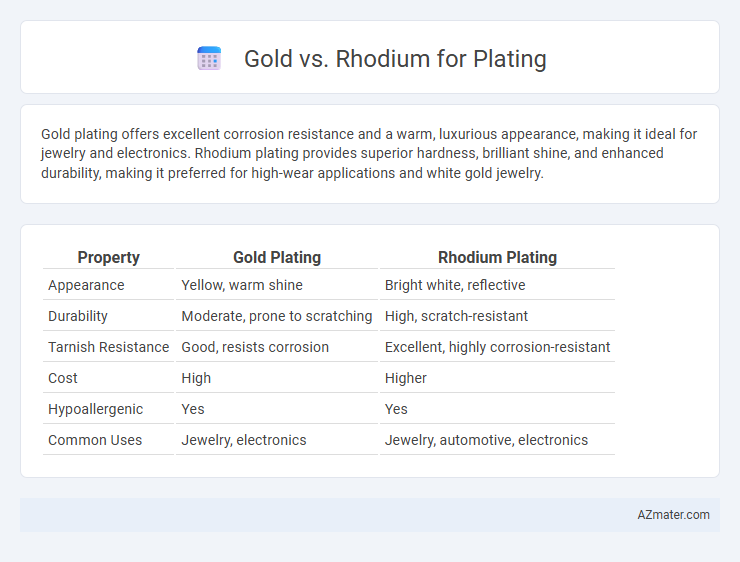Gold plating offers excellent corrosion resistance and a warm, luxurious appearance, making it ideal for jewelry and electronics. Rhodium plating provides superior hardness, brilliant shine, and enhanced durability, making it preferred for high-wear applications and white gold jewelry.
Table of Comparison
| Property | Gold Plating | Rhodium Plating |
|---|---|---|
| Appearance | Yellow, warm shine | Bright white, reflective |
| Durability | Moderate, prone to scratching | High, scratch-resistant |
| Tarnish Resistance | Good, resists corrosion | Excellent, highly corrosion-resistant |
| Cost | High | Higher |
| Hypoallergenic | Yes | Yes |
| Common Uses | Jewelry, electronics | Jewelry, automotive, electronics |
Introduction to Metal Plating: Gold vs Rhodium
Gold plating offers exceptional corrosion resistance and a warm, luxurious finish, making it ideal for jewelry and electronics. Rhodium plating provides a highly reflective, mirror-like surface with superior hardness and scratch resistance, commonly used to enhance white gold and silver pieces. Both metals improve durability and aesthetics but differ significantly in cost, appearance, and application suitability.
Physical Properties Comparison
Gold exhibits a high corrosion resistance and excellent malleability, with a Mohs hardness of approximately 2.5-3, allowing it to maintain luster while being easily workable for plating applications. Rhodium is significantly harder, with a Mohs hardness around 6, providing superior scratch resistance and durability in plating, especially for high-wear surfaces. Both metals offer distinct advantages: gold delivers exceptional conductivity and warmth in tone, whereas rhodium offers a reflective, bright white finish and increased resistance to tarnishing.
Appearance and Aesthetic Appeal
Gold plating offers a warm, rich yellow hue that enhances jewelry with a classic, luxurious appearance, while rhodium plating provides a bright, reflective white finish that resists tarnish and maintains a sleek, modern aesthetic. Rhodium's superior hardness and high reflectivity create a brilliant shine that highlights intricate details better than gold. The choice between gold and rhodium plating depends on the desired style; gold emphasizes traditional elegance, while rhodium delivers contemporary brilliance and long-lasting luster.
Durability and Wear Resistance
Rhodium offers superior durability and wear resistance compared to gold, making it ideal for high-traffic jewelry pieces and frequently handled items. Its hardness and resistance to tarnish extend the lifespan of plated surfaces, while gold plating, although aesthetically warm and luxurious, tends to be softer and more prone to scratching and fading over time. For applications demanding long-lasting protection and minimal maintenance, rhodium plating is the preferred choice.
Tarnish and Corrosion Resistance
Rhodium plating exhibits superior tarnish and corrosion resistance compared to gold, making it ideal for jewelry and high-wear applications exposed to harsh environments. Gold plating, while prized for its luxurious appearance, tends to tarnish over time due to oxidation and exposure to chemicals, requiring more frequent maintenance. Rhodium's hardness and inertness prevent surface degradation, ensuring long-lasting shine and durability in plating.
Cost and Market Value Differences
Gold plating costs significantly more than rhodium due to gold's higher market price and rarity, with gold trading around $60 per gram compared to rhodium's fluctuating prices, often reaching over $500 per gram in recent years. Despite rhodium's higher spot price, rhodium plating uses thinner layers, making it more cost-efficient for jewelry and automotive coatings. Market demand drives gold plating for its historical value and luster, while rhodium is favored for its superior hardness, corrosion resistance, and bright reflective finish, influencing overall pricing and consumer preference.
Applications in Jewelry and Industry
Gold plating offers exceptional corrosion resistance and a luxurious appearance, making it ideal for high-end jewelry and decorative applications. Rhodium plating provides superior hardness and tarnish resistance, widely used in jewelry to enhance durability and maintain a bright, reflective finish on white gold and silver pieces. In industrial settings, rhodium's excellent catalytic properties and resistance to wear make it valuable for electrical contacts and automotive components, whereas gold is favored for its excellent conductivity and oxidation resistance.
Maintenance and Longevity
Rhodium plating offers superior scratch resistance and maintains its bright, reflective finish longer than gold plating, making it ideal for high-wear jewelry items. Gold plating, while providing a warm and classic appearance, tends to wear off more quickly and requires more frequent reapplication to maintain its luster. Regular cleaning with mild soap and avoiding harsh chemicals prolongs the lifespan of both gold and rhodium plated pieces, but rhodium's durability significantly reduces maintenance needs over time.
Hypoallergenic Qualities
Rhodium plating is highly favored for its superior hypoallergenic qualities, as it is less likely to cause skin irritation or allergic reactions compared to gold. Unlike gold, which can contain nickel or other allergens in its alloys, rhodium is naturally inert and resistant to tarnishing, making it ideal for sensitive skin. This makes rhodium plating a preferred choice in fine jewelry for individuals seeking durable, hypoallergenic finishes.
Choosing the Right Metal for Your Needs
Gold offers excellent corrosion resistance and a luxurious appearance, making it ideal for decorative and jewelry plating that requires long-lasting shine and hypoallergenic properties. Rhodium provides superior hardness and reflectivity, perfect for enhancing durability and brightness on white gold and silver items, especially in high-wear applications. Selecting between gold and rhodium plating depends on factors such as desired color, durability, budget, and the specific usage environment of the plated object.

Infographic: Gold vs Rhodium for Plating
 azmater.com
azmater.com